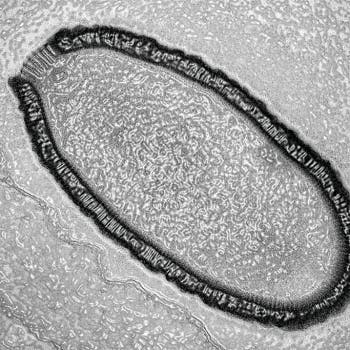Some 20.000 years ago, mammoths and other giant fauna roamed the Earth. So too did this giant virus – the only difference is that this virus, Pithovirus sibericum, is still around and doing fine.

Credit: Courtesy of Julia Bartoli & Chantal Abergel
Large enough to be seen under a light microscope, Pithovirus sibericum is not the first megavirus to be found, but at 1.5 micrometers (µm) in length, it is the largest. The average virus measures somewhere between 20 and 300 nanometers (nm), and the really big ones measure under 1.000 in length. If you’re not remembering your units of measure, 1 µ = 1.000 nm, so our megavirus measures 1.500 nm in length.
Two other families of giant viruses have been found in Chile and Australia, with genomes occasionally more complex than that of bacteria. Researchers found P. sibericum in the Siberian permafrost, hence the name (it’s long like a python and it was found in Siberia).
Discovery of this new family of Pithoviruses reveals that giant viruses are “much more diverse than initially assumed,” argue Chantal Abergel and Jean-Michel Claverie at the Structural & Genomic Information Laboratory at Aix-Marseille University, in France (Proc. Nat. Acad. Sci. USA, 2014, DOI: 10.1073/pnas.1320670111). Our huge virus doesn’t have a well developed capsid (protein shell), like most smaller viruses do. Instead, P. sibericum DNA is enclosed by a thick membranelike envelope, similar to that encasing Pandoravirus, the megavirus discovered in 2011. Although P. sibericum is 50% larger than the 1-µm-long Pandoravirus, its genome encodes much less proteins than the Pandoravirus.
But the nature of some of these proteins is still a mystery for researchers. The vast majority of these proteins are of unknown structure and function, a bounty of hundreds of ancient proteins “that simply don’t resemble anything we’ve seen before,” Abergel says. “There are more proteins here for structural biologists to study than is possible in a lifetime of work.”
“We also need to study their molecular mechanisms of infection,” comments Eugene V. Koonin, who studies megaviruses at the National Center for Biotechnology Information, in Bethesda, Md. Pithovirus, for example, appears to have a plug in its membranous envelope that must be “uncorked” for infection to occur, he adds.






